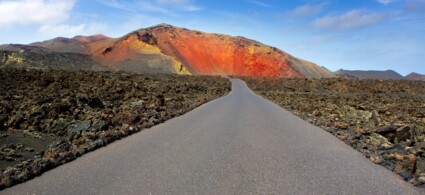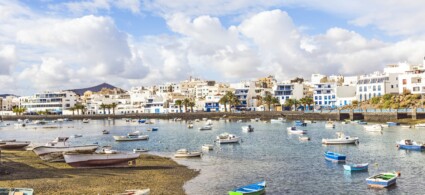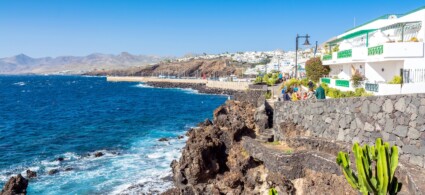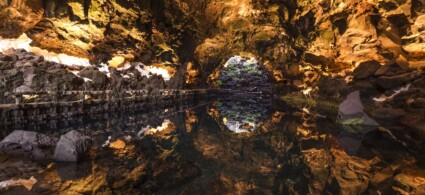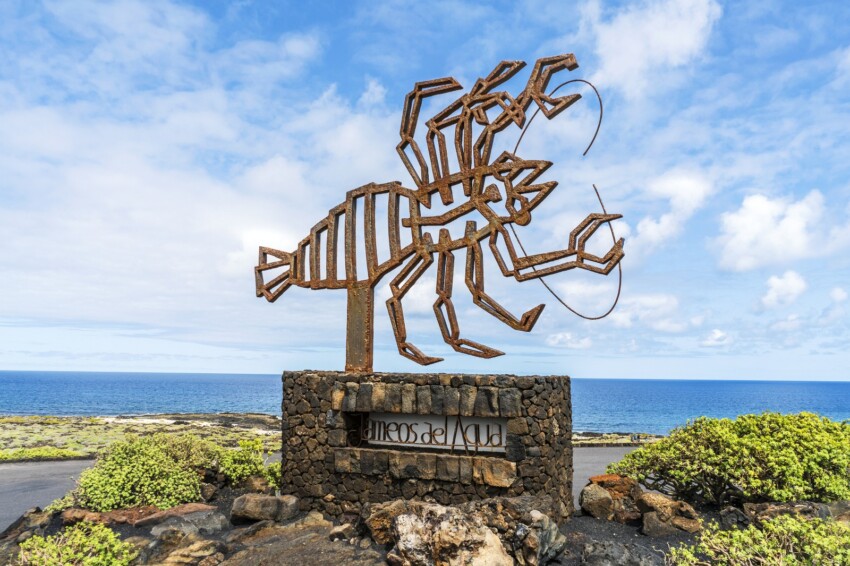

Spectacular volcanic landscapes and fine white sandy beaches make the island of Lanzarote one of the most popular destinations for Europeans. Lanzarote is the easternmost of the Canary Islands and lies 140 kilometres west of the African coast and is separated from the island of Fuerteventura by a channel some ten kilometres long.
The island, largely protected by a Biosphere Reserve and a National Park, is a true paradise for nature and sea lovers. Fourth in size of the Canary Islands archipelago, Lanzarote is an emblem of sustainable tourism thanks, in large part, to the works of the multifaceted artist Cesar Manrique, a native of the island, focused on land conservation.
Along its 250 kilometres of coastline, characterised by high cliffs and black lava landscapes, are sandy beaches and rocky coves. Ideal for surfing and windsurfing are the beaches of Orzola and Arrieta, both near the capital Arrecife, Playa Honda, near Lanzarote Airport, the beaches of Puerto del Carmen, La Santa and Playa Blanca.
If you love Canarian architecture, make a stop at the villages of Teguise, San Bartolome and Haria as well as the island’s capital. Puerto del Carmen, on the other hand, is the most important tourist centre.
Don’t miss the Mirador del Rio, from where you can enjoy a splendid view, the Timanfaya National Park, the Cueva de los Verdes and the Jameos del Agua in the Malpais de la Corona, the Jardin de los Cactus, the Lago Verde and the Castillo de San Jose.
The islets of La Graciosa, the smallest inhabited island in the Canary Islands, Alegranza, Montaña Clara, Roque del Este and Roque del Oeste, all in the Chinijo Natural Park, which lie off the northern coast of Lanzarote, are very beautiful.
Direct flights arrive at Lanzarote airport. The airport is located only 5 kilometres from the island’s capital Arrecife and is used by more than 40 airlines. It is also possible to reach Lanzarote by ferry thanks to the services of the shipping companies Transmediterranea, Fred Olson and Naviera Armas.
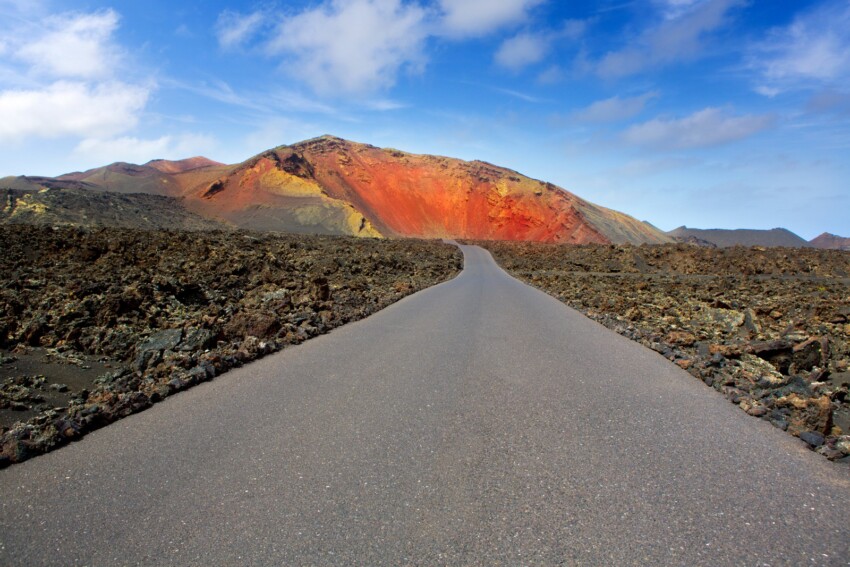
The Timanfaya and Fire Mountains National Park occupies a large part of the island of Lanzarote and is one of the must-see stops on an island holiday.
Volcanic cones, craters, the lava sea, black sand beaches and columns of lapilli create an extraordinary lunar landscape of great beauty. From the natural viewpoint of Montaña Rajada one can admire an immense sea of lava stretching all the way to the coast.
The spectacular multicoloured volcanic landscape, completely devoid of animal and plant life, stretches over some 51 square kilometres. During the 18th century, the island’s volcanoes erupted in violent explosions, covering the surrounding landscape and entire villages with incandescent lava and lapilli.
Inside the park is another project by Cesar Manrique, the El Diablo restaurant. Here, dishes are prepared on a barbecue fuelled by geothermal heat.
The Parque Nacional de Timanfaya can be visited from 09:00 to 17:00 by guided or coach tours organised by the Visitors’ Centre. Free access on foot is only allowed on the coast of the National Park.
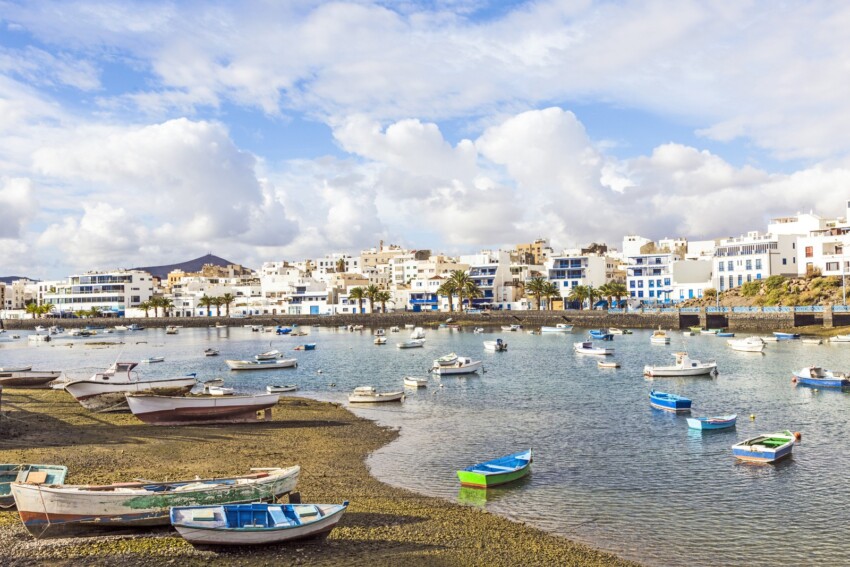
Beautiful and quiet, the port town of Arrecife is the liveliest on Lanzarote.
The town, which was founded in the 15th century and became the capital in 1852, is located along the east coast of the island, in a strategic position that allows quick and easy access to any point on the island. Its name derives from the cliffs (arrecifes) that rise above the sea not far away. Today it is home to shopping centres, numerous specialised outlets, gift shops and a number of small outlets that sell products and souvenirs with customer care.
In addition to the picturesque area of El Charco, the Mediterranean-style promenade is very beautiful, the ideal place for a moonlit stroll. Directly opposite, on a small island connected by a causeway, is the Castillo de San Gabriel, dating back to 1590 and now housing a museum dedicated to the history of Arrecife.
Of particular interest is the Castillo de San Jose, larger and more impressive than San Gabriel, built by King Charles III in the 18th century in the centre of the Bay of Naos when the town had to defend itself from pirates. It houses the International Museum of Contemporary Art with works by Picasso, Miró, Rivera and Sempere.
Shoppers will appreciate Calle Leon y Castillo, a long pedestrian street lined with quirky little shops and international designer boutiques. Finally, one of the most popular tourist attractions is the Charco de San Gines, a kind of lake formed by the flow of seawater into a kind of lagoon. Along the shores of the lake are characteristic fishermen’s houses and next to them stands the Church of San Gines.
A stone’s throw from the centre of Arrecife is the beach of Playa del Reducto, an expanse of light golden sand fringed with palm trees and safe for children, sheltered by Punta del Camello and the islet of Fermina. Two kilometres to the west is Playa del Cable.
On the outskirts of town, surrounded by a stunning volcanic landscape, is an 18-hole golf course.
Teguise, the former capital of the island, is 10 kilometres away.

The sophisticated resort of Playa Blanca is located along the southern coast of Lanzarote, within a wide gulf enclosing three smaller bays, overlooking the Bocaina Strait that separates the island from Fuerteventura and Lobos.
Playa Blanca is the ideal destination for those seeking a relaxing environment and great beaches. This quiet, family-friendly resort boasts a wide range of hotels, excellent tourist services, one of the island’s best harbours, from which one can reach the neighbouring island of Fuerteventura in 30 minutes, and is close to some of Lanzarote’s most beautiful beaches, such as the 4 at Punta del Papagayo.
Playa Blanca is 38 kilometres from Arrecife and 30 kilometres from Lanzarote Airport.
In the surrounding area, don’t miss the beaches of Dorada and Flamingo, famous for their white sand, the beautiful Timanfaya National Park, the wine-growing region of La Geria, the salt flats of Janubio, the Green Lake, the sheer cliffs over the ocean of Los Hervideros and the picturesque village of Yaiza.

Puerto del Carmen is located along the east coast of Lanzarote between the island’s capital Arrecife, from which it is 12 kilometres away, and the sophisticated resort town of Puerto Calero.
Puerto del Carmen, also known as Fariones, is the most fashionable resort on the island and is rich in services and comforts, excellent hotels, restaurants, shopping centres, discos, car rental agencies and excursion agencies.
The quaint old town is a must-see and the Avenida de Las Playas promenade, where numerous shops, restaurants, pubs and in general the hub of nightlife are located, is also very beautiful. Puerto del Carmen is indeed the destination on Lanzarote for those who love to party!
Puerto del Carmen boasts more than 6 kilometres of beaches including Playa Matagorda, Playa de los Pocillos, Playa Grande and Playa Chica.
The city is only 10 minutes away from Lanzarote Airport. If you want to discover the island’s traditions and way of life at first hand, travel to the villages of Conil, Mácher, La Asomada, Masdache, La Geria and Tías, all within the municipality of Puerto del Carmen.
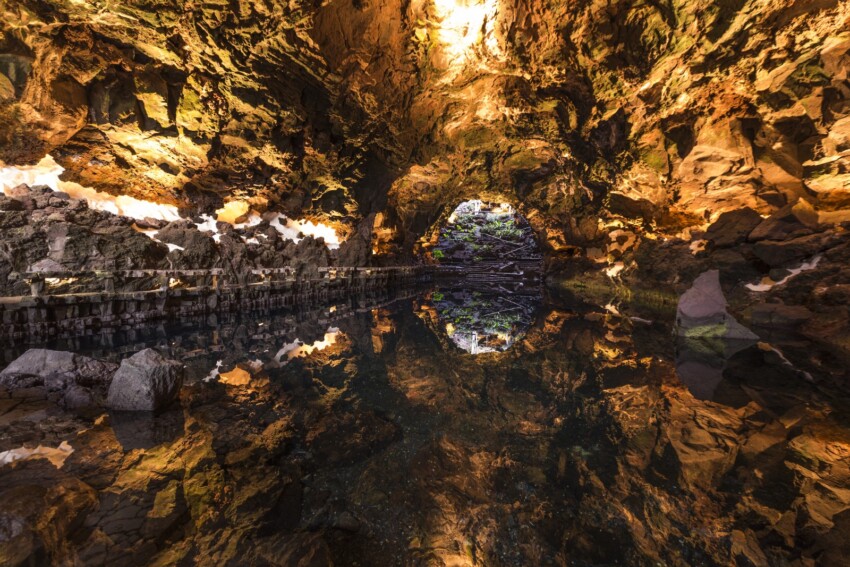
Within the lava fields of the Malpais de la Corona, near the coast of northern Lanzarote, are some fascinating volcanic tunnels, including the Jameos del Agua.
The evocative, almost lunar landscape of these 3 volcanic cavities, the Jameo Grande, the Jameo Chico and the Jameo de la Cazuela, have been transformed with extreme respect by the island’s most important artist, Cesar Manrique.
Inside the caves there is a salt lake connected to the sea, inhabited by tiny albino crabs and surrounded by a garden of palm trees and bougainvilleas, and numerous paths embellished with stalactites and stalagmites.
The Jameos del Agua perform a didactic and popularising task with regard to volcanology and geology. Within this unique setting there is also a 550-seat underground auditorium where amazing music festivals are organised.
It was César Manrique’s last major intervention on Lanzarote. Surrounded by the largest cactus plantation on the island, the Jardin de Cactus is home to some 4,500 specimens of 450 species grouped in 13 cactus families from five continents.
The green of the plants contrasts with the blue of the sky and the black of the volcano to create a harmonious explosion of colours that will not leave visitors indifferent. The garden is set in an unspoilt landscape, where the only sounds heard are those of nature.

The beautiful and picturesque traditional village of Haria is located in the hinterland of Lanzarote, not far from the Malpais de la Corona park, in what the islanders call the Valley of a Thousand Palms. In this village-oasis, the tradition of planting a palm tree at the birth of each child is still alive.
Along the narrow streets and alleys are numerous buildings in the Canary Island architectural tradition with stone walls and wooden balconies, while the León y Castillo square, overlooked by one of the village’s two churches, the Iglesia Nuestra Señora de la Encarnacion, which houses the Museum of Sacred Art, forms the centre of the village. Not far away are handicraft shops and small art galleries.
Haria is one of the greenest places on the island as tropical plants, cacti, prickly pears and numerous endemic plants grow luxuriantly thanks to a special humid microclimate that characterises the area. The Jardin de Cactus is worth a visit.
Near Haria there are several Miradors from which to admire spectacular views of Lanzarote. The best known are the Mirador del Rio, designed by artist Cesar Manrique who retired here, and the Mirador de Haria, 5 kilometres south of the village.
The geological attractions of Cueva de los Verdes and Jameos del Agua and the villages of Orzola, Arrieta, Charco del Palo and Punta Mujeres are worth visiting. Numerous trails popular with hikers and mountain bikers can be found in the area, such as the one leading to Bosquecillo, a beautiful forest area ideal for picnics.
In the municipality of Haria there are wonderful beaches, including some secluded and solitary coves. Don’t miss Famara, one of the most famous on the island, Playa Risco, accessible only by boat or via a steep path, Caleta del Mero, La Cocinitas, Playa Canteria and El Caleton Blanco.

The traditional village of Teguise is located in the northern interior of Lanzarote just 12 kilometres from the capital Arrecife and 18 kilometres from Lanzarote Airport.
With more than five centuries of history, Teguise, the former capital of the island, preserves a rich artistic and cultural heritage.
Very beautiful are the Church of Nuestra Senora de Guadalupe in Plaza San Miguel, built in the first half of the 16th century and presenting a mixture of different architectural styles, the Franciscan Convent in Baroque style converted into a Museum of Sacred Art and the Spinola Palace, built between 1730 and 1780, among the best examples of Canary Island architecture on Lanzarote.
Don’t miss the marvellous Castillo de Santa Barbara, a 16th century fortress characterised by its strong square towers, from where you can enjoy a unique view of Teguise.
Don’t miss the contemporary art gallery, where works by internationally renowned artists are exhibited, housed inside the Dominican Convent founded in 1698.
The Canarian carnival celebrations are very beautiful when the masks of the figure of the little devil, symbol of virility and fertility, parade to the rhythm of music.
Every Sunday morning Teguise is animated by a famous market, the Mercadillo, which transforms the village into a veritable bazaar.
Costa Teguise, one of Lanzarote’s most popular and sought-after tourist areas and boasting no less than five wonderful beaches, is a 15-minute drive away.
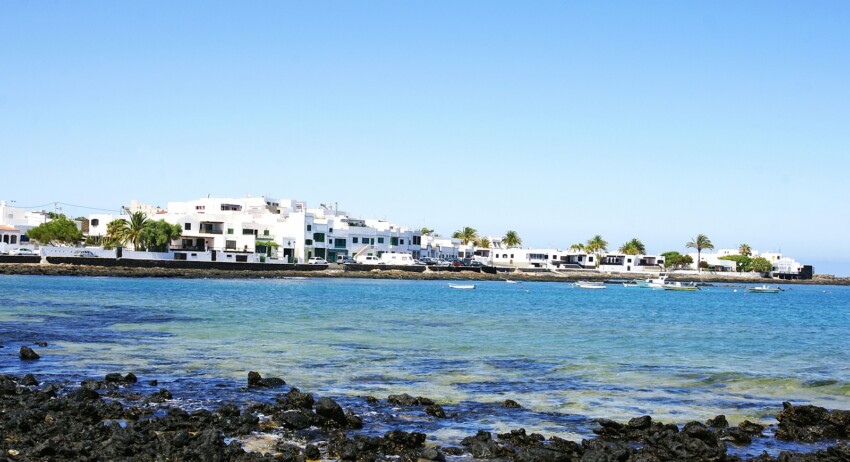
The sought-after resort of Costa Teguise is located along the east coast of Lanzarote, north of the capital Arrecife and a 15-minute drive from the airport.
A family favourite, Costa Teguise offers a wide range of accommodation, services and recreational facilities including an 18-hole golf course and a water park. Noteworthy is the Pueblo Marinero, a group of buildings designed in traditional Canarian style by architect and artist Cesar Manrique.
Among the most important attractions of Costa Teguise are the sandy beaches: Playa de las Cucharas, most popular with windsurfers, Playa Bastian, ideal for families with small children, the white sand beach of Playa Jablillo and Playa de los Charcos.
Don’t miss the picturesque El Charco, a lagoon surrounded by fishermen’s houses with excellent fish restaurants, and the traditional villages of Arrieta and Haria.
The nightlife in Teguise is animated by pubs and discos.
Lanzarote’s only Aquapark is located in Costa Teguise, just before the golf club, 15 minutes north of the capital Arrecife. The Aquapark includes a large area for children with bouncy castles and trampolines, a large pool with slides for children, closed and open slides for adults, a Paintball circuit and an adventure park.
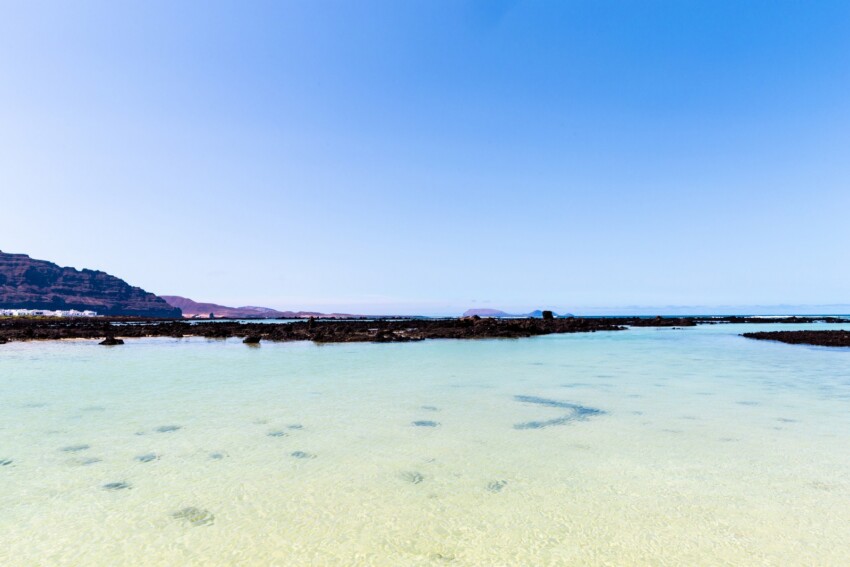
The fishing village of Orzola is located on the northern tip of the island of Lanzarote and is known for its beautiful beaches and numerous points of interest in its surroundings.
Orzola has managed to retain its old charm and is an enchanting place to spend a holiday.
Around the harbour, a key junction for connections between Lanzarote and the small island of Graciosa, the largest in the Chinijo archipelago, are renowned fish restaurants.
Not far away are the picturesque beaches of Playa de La Canteria, Playas Caletones, Playa El Risco, Charca de la Laja and Caleta, Caleton Blanco del Mero, the beautiful Mirador del Rio and the Pardelas Park, an ideal place for families with small children one kilometre from the centre of Orzola.

The picturesque town of San Bartolome, an ideal place to enjoy Canarian cuisine, is located in the agricultural heart of Lanzarote and is the second most important town on the island after the capital Arrecife.
Notable buildings to visit include the Casa Ajei, now a cultural centre, and the 18th century Casa del Mayor Guerra, examples of the island’s traditional architecture. Next to the Casa del Contadino, you can also admire a large sculpture by the multifaceted artist Cesar Manrique, an illustrious son of Lanzarote whose birthplace, which now houses a foundation in his name, is located just outside the village.
The surroundings of San Bartolome should definitely be explored. To the north of the town lies the fertile land of the jable, while to the south are the picturesque vineyards of La Geria, where the vines are grown inside holes dug in the ground and protected from the wind by small semi-circular stone walls. Also not to be missed is an excursion to the Timanfaya National Park.
Although located in the centre of the island, San Bartolome has easy access to some of Lanzarote’s beautiful beaches such as Playa Honda and Guacimeta.

The resort of Playa Honda is located along the east coast of Lanzarote between the island’s capital Arrecife, from which it is 6 kilometres away, and the town of Puerto del Carmen.
With its relaxed atmosphere, Playa Honda is the ideal place for a quiet and sophisticated holiday. Its tourist offer is of a high standard and consists largely of hotels and luxury villas for rent.
Playa Honda is famous for its 2 km long and 80 m wide golden sandy beach. Not far away is Guaciameta beach, which runs alongside the airport runway.
Playa Honda is located just 2.5 kilometres from Lanzarote Airport.
Puerto Calero, on the outskirts of Puerto del Carmen, along the east coast of Lanzarote, 20 kilometres south of the capital Arrecife, is among the most exclusive and prestigious destinations in the Canaries for sailing enthusiasts.
This young and modern tourist resort, established as one of the most exclusive and modern marinas in Spain, boasts excellent hotels, including luxury hotels, 420 berths, numerous exclusive villas, cafés and restaurants on the waterfront.
Puerto Calero does not have its own beach but there are some outstanding ones nearby, including Playa Grande, Playa Pocillos and Playa Chica, while Playa Quemada and Punta del Papagayo are a 20-minute drive away.
Puerto Calero is 10 kilometres from Lanzarote Airport.
The Cesar Manrique Foundation is the institution responsible for the supervision of the works of the artist, one of the most illustrious exponents of Lanzarotean culture, and is located within his former residence in Tahiche, a village not far from Arrecife, the capital of the island of Lanzarote.
Manrique, painter, sculptor, architect and ecologist at the same time, had an unmistakable style. The influences of his art can be found in the cheerful and sunny style of 20th century Spanish painting, from Picasso to Miró.
The Foundation’s collection of contemporary art and the projects of the Mirador del Rio, the Marine Park in Ceuta and the Cultural Centre in Seville can be admired upon entering the house museum, which he designed, decorated and built following the natural structure of lava on the ground.
After the visit, one can enter the gardens of Taro Tahiche where one can appreciate the large mural executed by the artist himself with volcanic stones and tiles.

Lanzarote’s Lago Verde, a short distance from the village of Golfo on the west coast of the island, is one of the spectacular examples of the power of Nature.
In the lower part of the semi-submerged volcanic cone, formed after the eruptions of 1730, at the foot of the cliff, one can admire a half-moon-shaped lagoon, rich in volcanic minerals and micro-organisms, separated from the waters of the Atlantic Ocean by a beautiful beach of black pebbles.
Lago Verde, whose colour is due to phytoplankton and whose emerald-green hue varies according to the colour of the sky, has been declared a nature reserve and is located within the Lanzarote Volcanoes Natural Park. A number of sheltered bays with black beaches connect the lagoon with the quiet village of Golfo.
Nearby is olivina, a hard stone from which local craftsmen make some original jewellery.
The volcanic landscape of the Malpais de la Corona, created by an eruption some 3,000 years ago when lava flowed eastwards, is located in the northern part of the island of Lanzarote and includes the famous volcanic caves of Jameos del Agua and the Cueva de los Verdes.
To visit the lava fields of La Corona you can start from the traditional village of Orzola, but you must be well equipped as the terrain is rocky and uneven, or drive along the LZ 1 road.
Mount Corona, 609 metres above sea level, is the highest of the five now-extinct volcanoes that created this landscape with their eruption. The semi-circular volcanic crater face, about 450 metres in diameter and 190 metres deep, can be reached by a steep path requiring appropriate equipment.
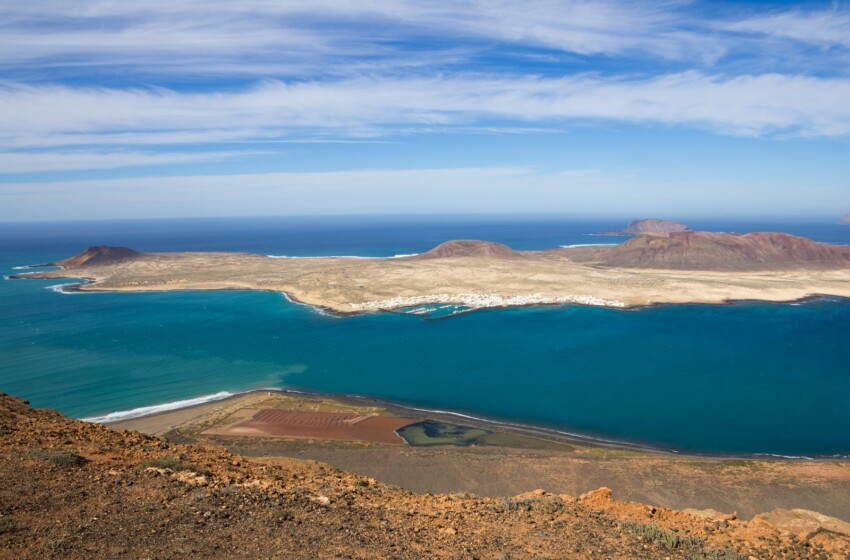
The panoramic view from the Mirador Del Rio, located in the northern part of Lanzarote, behind Playa El Risco and not far from the village of Orzola and the Malpais de la Corona, is breathtaking.
The Belvedere, designed in 1973 by the local architect and artist Cesar Manrique, is located 497 metres above sea level, on top of the imposing Famara cliffs, and offers one of the most spectacular views of Lanzarote: the northern coastline, the abandoned salt marshes, the El Rio strait, the island of la Graciosa and the beautiful Chinijo natural park.
The Mirador building is barely perceptible from the outside as the structure is hidden under a series of volcanic stones that camouflage it with its surroundings. Inside the building, accessible via a corridor decorated with traditional ceramics, you will find a restaurant and an elegant bar that will project you outside thanks to two huge, sinuous windows.
A souvenir shop is located on the upper floor and can be reached via a spiral staircase.
The 700-square-kilometre Chinijo Nature Park in the north of Lanzarote is Europe’s largest marine reserve and includes the islands of Graciosa, Alegranza, Montaña Clara, Roque del Este, Roque del Oeste, the Famara cliffs and the Malpais de la Corona.
The landscape is characterised by the presence of volcanic structures and is the nesting area of numerous birds and some birds of prey such as the fish eagle and queen’s hawks. In addition, as many as 228 species of fish inhabit the waters of the Chinijo archipelago.
Biologically, the park, established in 1995, is the richest and most diverse in the Canary Islands and prohibits all types of fishing other than professional fishing.
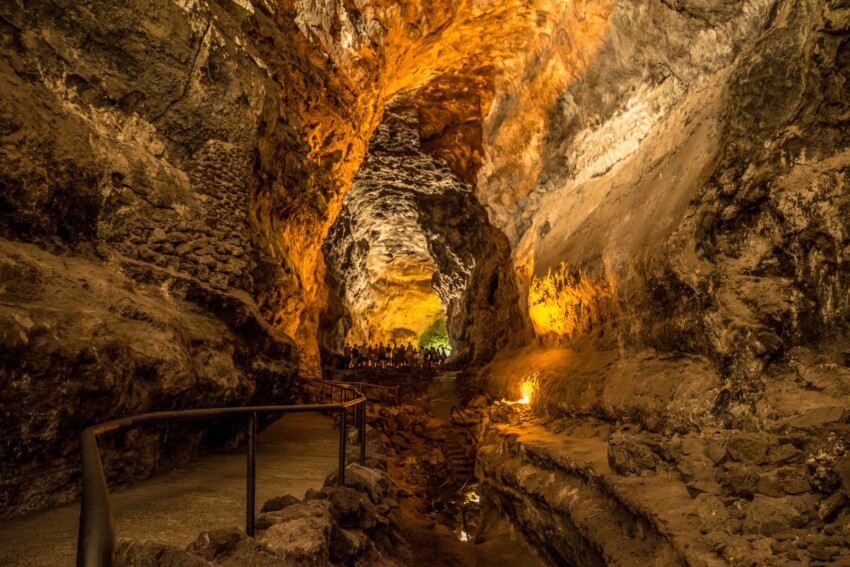
The Cueva de los Verdes is a legendary cave. Formed after the eruptive activity of the Corona volcano, it is one of the most amazing hidden wonders in the bowels of Lanzarote.
It was used as a hiding place by locals against attacks and invasions by pirates from North Africa during past centuries, and from 1900 onwards it became a must-see for European scholars and scientists fascinated by this unique volcanic formation.
The colour range of ochre, grey, black and red in this paradise of darkness helps to draw grotesque landscapes and spectacular rock structures that surprise visitors. Entering the Cueva de los Verdes is undoubtedly comparable to a journey to the centre of the earth.
Tickets for the Cueva de los Verdes can only be purchased online, as there is no ticket office on site.
There are a number of inland villages on Lanzarote that can be chosen to stay in, ideal places for those who want to alternate a beach holiday with a trekking and hiking holiday. These are less touristy areas, making them perfect for those in search of peace and tranquillity.
For example, Tahiche20 is known as the birthplace of the famous artist César Manrique. His personal residence El Taro is built in a lava setting and is one of the most famous tourist sites on the island.
Finally, the village of Femés21 is located at the top of a valley at the edge of the fabulous mountains, known as Monumento Natural de Los Ajaches, and overlooks Playa Blanca and the Bocaina Strait.
In the following map you can see the location of the main places of interest mentioned in this article.
